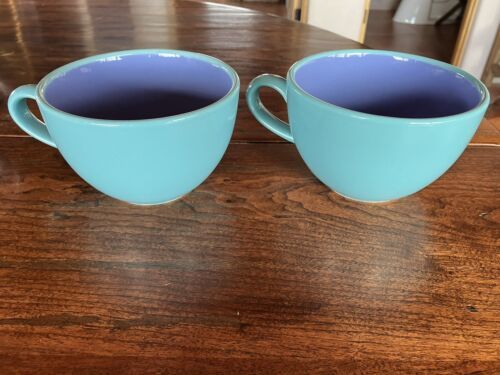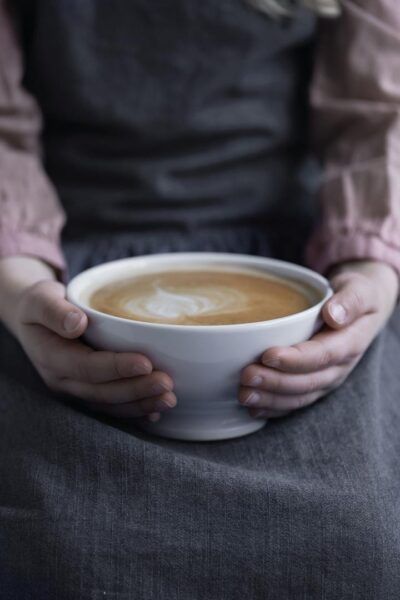#Collecting #Café #Lait #Bowls #WorthPoint
There are few greater pleasures than sipping a creamy hot cup of coffee from a cheerful ceramic café au lait mug. Oversized, colorful, and often handleless, these French-style vessels are prized by collectors and coffee lovers alike. Knowing what to look for at estate sales or thrift stores is a wise move if you’re a flipper like me.
But First, Coffee
Before we relish the bowl, let’s learn about that lovely liquid bliss that fills it. Allison Gainey of the CoffeeGeek Blog defines café au lait as “something very French. Very Parisien. Very morning in Paris.”
She explained that the traditional café au lait recipe of equal parts coffee and milk is made using a French moka pot heated on the stove. This all means that a French-style breakfast is an intentional and in-the-moment event. Slowly heating coffee and rich milk and pouring it into a vibrant, oversized bowl is part of the joy, not to mention the handmade breakfast beignets on the side, ready for dipping.
What Is a Café Au Lait Bowl?
I have always loved collecting coffee mugs, but café au lait bowls, usually measuring at least five inches in diameter and without handles, make it easy to soak up the coffee experience. They’re made to hold with two hands, which forces focus on the beverage and food. This calming experience is likely why these petite pots have been around for centuries and possess a history as rich as the beverage.
Let’s briefly delve into the history of these charming vessels. Turkish and Chinese vendors introduced coffee and tea to the Europeans, teaching them the custom of drinking from cups without handles. In France, café au lait bowls can be traced back to the early 1600s when a physician named Pierre de la Roque returned from a trip to Constantinople with his luggage bags full of coffee beans and café au lait bowls. These pieces, with their rich history and enduring charm, are a testament to the timeless appeal of coffee culture.
Starting a Collection
If you want to begin collecting café au lait bowls, the price ranges from a few dollars to hundreds, depending on age, style, and condition.
Additionally, Martha Stewart magazine writer Meg Peterson wrote that many vintage and antique bowls in circulation today are French and German pieces from the 1920s to the ’40s and are challenging to find. She noted that many pieces come in an array of patterns stenciled in primary colors in a bold art deco style. Others are transferware pieces with detailed images. She added that solid-color bowls were made from tinted clay before being fired in a kiln.
Just because antique pieces are likely elusive doesn’t mean they don’t exist—you could get lucky if you know what to look for. There have been times when I thrifted something that looked remarkable. For example, I purchased a $15 original signed painting at a thrift store and sold it for $150. Why did I buy it? I felt it was special, even though a fellow shopper had put it back, calling it “ugly.” I don’t recommend this for every purchase, but like they say, “If you know, you know.”

Flipping Café Au Lait Bowls
When you’re thrifting to resell these bowls, remember their versatility. They’re not just for coffee but also perfect for cereal, soup, or snacks. If you’re listing café au lait bowls in your online store, consider adding keywords like “breakfast bowl,” “cereal bowl,” and “snack bowl” to attract a broader range of potential buyers. And if you know the brand name, be sure to include it early in your listing. Café au lait bowls under names like Pier 1, Williams Sonoma, and Crate & Barrel are often solid sellers. I also discovered lesser-known brands from the WorthPoint database that are worth remembering. Here are a few:
- Henriot Quimper: This vibrant ceramic collection from France includes hand-painted farm scenes and flowers.
- Keller & Guerin: Antique bowls from this French company usually have a floral or transferware pattern.
- Lindt Stymeist: The 1980s Colorways line is bold and modern with bright colors.
- Pillivuyt French Porcelain: Made in France and sold worldwide, these sturdy bowls possess modish, sleek designs with minimal decoration.
- Rae Dunn: While some feel Rae Dunn products are not worth reselling, I found several of her early café au lait bowls that sold for hundreds.
- Villeroy and Boch: Many sold items included a line of modern white café au lait mugs with matching snack plates.
- Waechtersbach: Antique pieces from this German company, which closed in 2011, are elusive but can still pop up when you least expect them.
Enjoy the Coffee Experience
These days, I often feel like I’m living in a rushed, almost upside-down world that starts with coffee on the run in my beastly steel thermos mug accented with a blueberry muffin in a bag. But this weekend, I may pull out my colorful turquoise and purple mug that, until researching this blog post, I had not realized was a vintage Lindt Stymeist.
See? Whether you’re collecting or reselling, knowledge is power. If you know, you know!
Between excursions to hunt for antiques and vintage décor, Lynda Houston is busy restoring her 1950s cottage in Cincinnati, Ohio. She and her partner, Dave Beck, operate TheRustInPeaceShop on Etsy.
WorthPoint—Discover. Value. Preserve.




